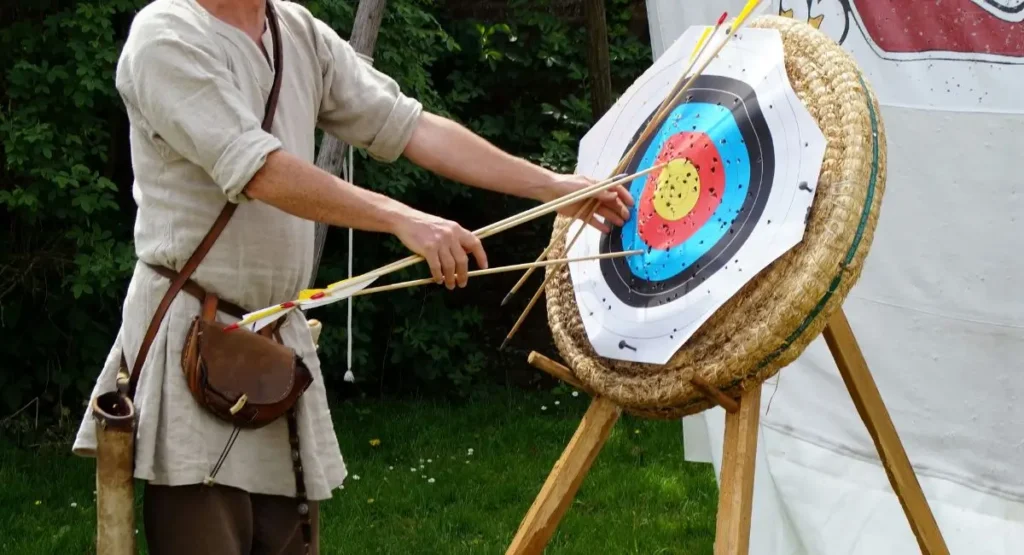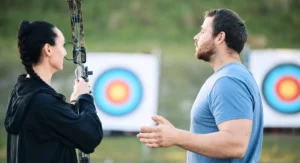A time-honored skill that combines focus, strength, and strategy, traditional archery is more than just a hobby, you are not alone. If you’ve ever been captivated by archers’ grace and precision in movies or competitions, you are not alone. We will introduce you to traditional archery in this comprehensive guide, along with its historical significance, benefits, and tips to get started. We are your go-to resource for all the info you need to know about traditional archery, whether you are looking to hit the bullseye or just enjoy a connection with nature.
Introduction To Traditional Archery
Historically And Culturally Significant
The use of archery has played an important part in the culture of many cultures for thousands of years. From the ancient Egyptians up to the English longbowmen, archery has played a significant role in the history of different cultures.
There has been a lot of pride in traditional archery for generations. It is associated with precision, discipline, and tradition. Modern archery enthusiasts reconnect with history while honing their skills and getting back in touch with their roots.
The Definition And Main Elements
Traditional archery is archery using simple, non-mechanical bows and arrows. Contrary to modern archery, which utilizes advanced technology and sighting systems, traditional archery emphasizes basic skills and techniques. A shot is made up of a bow (longbow, recurve bow, or horsebow) and an arrow (often made from wood). Each element is crucial to both its art and its practice.
The Benefits Of Traditional Archery
Physical Benefits
Traditional archery has significant physical benefits. Pulling back a bowstring builds upper body strength, engaging muscles in your back, shoulders, and arms. Furthermore, drawing a bow requires coordination and balance, improving overall body control. Over time, regular practice can enhance your posture, as the sport encourages a strong, upright posture.
Mental Benefits
Traditional archery is not only a great way to get fit, but also a powerful mental development tool. Concentration and focus are essential when aiming at a target. Through this practice, you can learn to control your breathing and maintain a calm mindset, which can reduce stress and foster discipline. Among archers, there is often a sense of meditative quality to the sport, encouraging mindfulness and self-reflection.
Traditional Archery Bow Types
Longbow
Traditional bows like the longbow are known for their simplicity and effectiveness. Longbows are typically made from just one piece of wood, and they offer a smooth, powerful draw and are nearly as tall as the archer. Their simplicity makes them a great choice for beginners. Longbows have minimal accessories that allow archers to focus on their fundamentals.
Recurve Bow
The limb tips of recurve bows curt away from archers when unstrung. This design allows for enhanced power and speed, making recurve bows a popular choice for both beginners and experienced archers. Their compact design makes them easy to transport, so they are suitable for outdoor adventures as well as target shooting.
Horsebow
Mounted archers traditionally used horsebows because they are flexible and quick to shoot. They are often made with layers of different materials, providing strength and resilience. These bows are shorter and often made with layers of different materials. It isn’t just practical to ride horses with horsebows, but also historical. Although they are more skill-intensive to master, traditional archery’s many styles can be explored in this way.
What Is The Best Bow For Beginners?

Aspects To Be Considered
To have a positive archery experience, it’s important to choose the right bow. The key factors to consider are the draw weight, the bow length, and the materials used in the bow.
Draw weight refers to the amount of force needed to pull the bowstring back. For beginners, a lower draw weight (15-30 pounds) is often recommended to build strength and technique efficiently.
Bow length should correspond to your height; a taller person may require a longer bow for optimal performance. Materials also play a role; wooden bows provide authentic experiences, while fiberglass options offer durability and cost-effectiveness.
Recommendations
Samick and Bear Archery are both known for their beginner-friendly recurve bow designs, so consider buying one for those just getting started. Whether you are looking for a more traditional aesthetic or a more modern style, a handcrafted longbow may be an excellent choice. These bows are versatile, adjustable, and come in various draw weights, making them easy to find the right fit. Find something that suits your needs by consulting with local shops or experienced archers.
An Arrow For Traditional Archery
Types Of Arrows
When it comes to arrows, several materials can be selected based on your bow type and shooting style. Wooden arrows offer an old-fashioned feel and are often preferred in traditional archery. However, they require more maintenance and care. Aluminum arrows are durable and consistent. In contrast, carbon arrows are lightweight and accurate but may not provide the same traditional experience.
Choose The Right Arrows
You should also consider the specifications and shooting style of your bow when selecting the right arrows. For example, wooden arrows are ideal for traditional bows, providing a more authentic shooting experience. When selecting arrows, be sure to check their spine rating, which indicates how stiff they are; this should correspond to the draw weight of your bow.
The Essential Gear And Accessories
Protective Gear
Safety should always be a top priority in archery. Essential protective gear includes armguards to protect your forearm from the bowstring and finger tabs or gloves that shield your fingers while gripping the bowstring. These accessories enhance comfort and improve shooting accuracy by preventing slippage.
Other Essentials
In addition to protective gear, consider investing in other accessories such as quivers for carrying arrows, bowstrings for replacements, and maintenance tools like string wax and bow cases. Having the right equipment ensures you are prepared for archery practice and keeps your gear in top condition.
Basic Techniques For Beginners
Stance And Grip
Mastering the correct stance and grip is the foundation of successful archery. Stand with your feet shoulder-width apart, with your non-dominant foot slightly forward. Your grip on the bow should be relaxed, allowing the bow to rest in your hand without excessive tension.
Drawing And Aiming
To draw the bowstring, raise your bow arm while simultaneously pulling back the string with the three fingers of your dominant hand. Use your eyes to align with the target—this is where focus and steady breathing play a crucial role. Practice aiming by visualizing the target and letting instinct guide your shot.
Release And Follow-Up
Having a release is crucial to accuracy. Release the string smoothly without jerking or flinching. Allow your bow arm to extend towards the target and maintain your focus until the arrow hits. Over time, Practicing this technique consistently will make you a better shooter.
Best Practices And Tips For Traditional Archery
Practice Regularly.
Consistency is the key to improving your archery skills. Set aside time each week to practice, whether at a range or in your backyard (if space allows). Regular practice enhances muscle memory and makes techniques second nature.
Joining Archery Clubs Or Groups
Finding a community of fellow archers can be beneficial. Joining an archery club or group offers opportunities to learn from experienced archers, participate in group practices, and share your passion with others. Community engagement fosters growth and motivation.
Setting Realistic Goals
Start by setting achievable goals for your archery practice. Whether it’s improving your accuracy or mastering an advanced technique, having clear milestones helps track progress and keeps you engaged. Celebrate your successes, no matter how small!
Traditional And Modern Archery Comparisons
Techniques And Equipment Differences
Traditional archery focuses on simple bows and arrows, but modern archery incorporates technology for precision. Modern bows may include sights, stabilizers, and advanced materials that enhance performance. If you understand the differences between traditional methods and modern methods, you can appreciate them better.
Pros And Cons Of Each
It emphasizes skill over technology and is strongly connected to history. Although it may take more practice to reach the same level of accuracy as modern equipment, it is still possible. On the other hand, modern archery can deliver instant results, but lacks traditional charm and discipline. Decide which style works best for you.
Conclusion
This ancient art of archery is a rewarding hobby that offers an outstanding blend of physical activity, mental focus, and a deep-rooted history. With numerous benefits, including a greater sense of strength and mental clarity, it is no wonder more people are experiencing this ancient hobby.
The thrill of hitting a bullseye is just around the corner, so if you are ready to take your first steps into traditional archery, make sure you choose the right equipment, practice regularly, and engage with your local archery community.
Frequently Asked Questions
How To Get Started With Traditional Archery?
Begin by researching your local archery clubs, selecting the right bow and arrows, and practicing fundamental techniques.
How Do Beginners Learn Archery?
Beginners typically start with lessons from experienced archers or clubs that offer coaching programs to ensure proper techniques are learned.
What Type Of Bow Should A Beginner Use?
A recurve bow is often recommended for beginners due to its versatility and ease of use.
What Are The 3 Rules Of Archery?
- Always point your bow in a safe direction.
- Only shoot at targets you know are clear.
- Follow all safety instructions provided by your instructor or facility.
Is Archery An Expensive Hobby?
Costs can vary, but starting with a basic bow and arrows can be relatively affordable. Optional equipment and accessories can increase the expense.
What Is The Best Age To Start Archery?
There is no specific age limit; children as young as 8 can start with appropriate supervision, while adults can pick it up at any age.
With patience and practice, anyone can master traditional archery. Grab your bow and start today!
Recommended Articles
- Discover The Art Of Crossbows And Their Many Uses
- Longbows For Beginners: A Beginner’s Guide
- Discover The Joy Of Archery With A Bow And Arrow For Beginners
- Traditional Archery For Beginners – Getting Started
- Hit The Target With This Ultimate Guide To Archery For Beginners
- Mastering The Art Of Recurve Bow Archery For Beginners








8 thoughts on “Traditional Archery For Beginners – Getting Started”
Comments are closed.